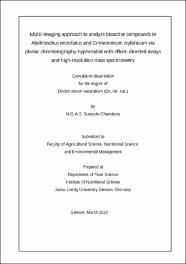| dc.contributor.advisor | Morlock, Gertrud | |
| dc.contributor.author | N.G., A.S. Sumudu Chandana | |
| dc.date.accessioned | 2022-06-09T09:47:48Z | |
| dc.date.available | 2022-06-09T09:47:48Z | |
| dc.date.issued | 2022-03 | |
| dc.identifier.uri | https://jlupub.ub.uni-giessen.de//handle/jlupub/1252 | |
| dc.identifier.uri | http://dx.doi.org/10.22029/jlupub-1094 | |
| dc.description.abstract | Citizens in developing countries rely on indigenous knowledge and practices and use locally available medicinal plants for different treatments. Most of these plants have not been investigated for their chemical composition or physiological properties. While for some plants, the whole plant extracts have been tested for their bioactivity, most of the individual compounds and their effects have still not been identified. The separation of bioactive compounds from natural sources is a challenging task. Undoubtedly, hyphenated approaches like high-performance HPTLC combined with EDA and mass spectrometry, provide impressive opportunities for the identification of natural products without prior tedious compound isolation. Separating complex plant-based samples into individual compounds and studying their effects allows us to study the potential impact of medicinal plants on consumers. These findings can be used to substantiate current traditional medicinal knowledge and to evaluate their benefits, risks and limitations. The newly developed hyphenated HPTLC-UV/Vis/FLD-EDA-HESI-HRMS method for identification of single compound effects in Sri Lankan Abelmoschus moschatus and Cinnamomum zeylanicum included (1) non-target screening, (2) assignment of prominent individual bioactive compounds, and (3) comparison of product profiles to check the quality of commercial products. Both studies revealed not only the phytochemical but also the prominent bioactive constituents or fractions in the multi-compound mixtures. Diverse antimicrobials, antioxidants and inhibitors of glucosidase, tyrosinase and cholinesterase were detected. Running reference materials in parallel to identified compounds, confirmed the assignments and biological effects. The HPTLC-UV/Vis/FLD-EDA analytical work flow can be used in developing countries for profiling and valorization of plant-based foods, botanicals and medicinal herbal preparations. | de_DE |
| dc.language.iso | en | de_DE |
| dc.relation.haspart | https://doi.org/10.1016/j.talanta.2020.121701 | de_DE |
| dc.relation.haspart | https://doi.org/10.1016/j.foodchem.2021.129135 | de_DE |
| dc.rights | In Copyright | * |
| dc.rights.uri | http://rightsstatements.org/page/InC/1.0/ | * |
| dc.subject | EDA | de_DE |
| dc.subject | HPTLC | de_DE |
| dc.subject | Abelmosk | de_DE |
| dc.subject | cinnamon | de_DE |
| dc.subject.ddc | ddc:500 | de_DE |
| dc.title | Multi-imaging approach to analyze bioactive compounds in Abelmoschus moschatus and Cinnamomum zeylanicum via planar chromatography hyphenated with effect–directed assays and high-resolution mass spectrometry | de_DE |
| dc.type | doctoralThesis | de_DE |
| dcterms.dateAccepted | 2022-06-02 | |
| local.affiliation | FB 09 - Agrarwissenschaften, Ökotrophologie und Umweltmanagement | de_DE |
| thesis.level | thesis.doctoral | de_DE |



